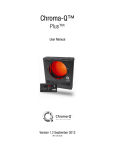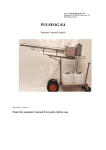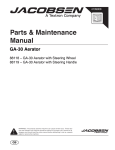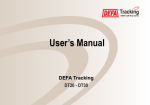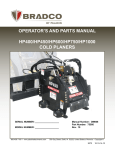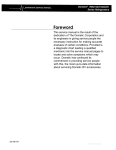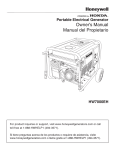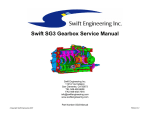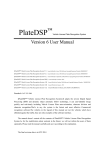Download Technical Specification - Mobility Scooters Plus
Transcript
EMERALD 4-WHEEL Scooters Workshop Manual EN G LI SH EMERALD WORKSHOP MANUAL The Emerald mobility scooter is a versatile outdoor/indoor, 4-wheeled machine. Features include; Adjustable Tiller assembly, Padded seat with width adjustable armrests, Seat slide, Seat swivel, Headrest, 3-Amp off-board automatic charger, Integrated lights & indicators, Hazard warning lights, Front shopping basket and Carpeted floor matt. Sunrise Medical is ISO 9001 certified. This product is manufactured to comply with the requirements of EEC directives 89/336/EEC CE CONTENTS Product Information Safety Information Recommended Tools Service/Inspection Technical Specifications Front Wheels Rear Wheels Tyres & Tubes Seating Seat Stem Batteries & Charger Separating the Scooter Rear Drive Assy. Ties & Plugs Rear Lights Main Control Box Drive Train Assy. Motor & Brake Assy. Rear Chassis Assy. Tiller Assy. Front Body Panel Assy. Front Body Panel- Lights Front Body Panel- Bumper Main Frame Assy. Steering Rods Steering Head Stub Axles Front Suspension Assembly Reference Photographs 1-1a 2- 3 4 5 6 7- 9 10 11-12 13-16 17 18 19 20 21- 22 23 24- 26 27- 28 29- 30 31- 35 36- 37 38- 39 40 41 42- 44 45 46 47 48- 51 1 IMPORTANT It is potentially hazardous to fit or use any parts other than genuine Sunrise Medical parts. The company disclaims all liability for the consequences of such use, which in addition, voids the machine warranty. This vehicle is for the carriage of ONE PERSON And must not be used for any other purpose. 1a EMERALD Safety Whilst working on powered mobility products, it is essential to observe good working practice. Below are a series of safety guidelines and recommendations. Please note that these precautions are intended to serve only as a guide and are not intended to supersede or replace any safety statute, NHS or other safety regulations. General • • • • Always wear suitable protective clothing when handling batteries. Always wear suitable eye protection when drilling or inspecting. When safe to do so, wear protective gloves when handling the running gear or batteries, as these parts are exposed to paths, parks etc. If the drive wheels have to be raised of the floor, always use a pair of axle stands to secure the vehicle correctly. Batteries All work carried out on batteries or battery boxes should demand a degree of extra caution. • • • • • • • • • • • Always make sure that the batteries are disconnected from the vehicle before commencing work. Always check that the battery charger is disconnected from the vehicle / batteries before commencing work. Do not smoke. Keep batteries away from all sources of ignition. Do not place objects on the battery tops. Always try to keep someone within earshot of your work area so that they may come to your assistance if needed. Always wear personnel protection when handling batteries including, eye / face protection and gloves. Make sure there is easy access to soap and water in case of acid spills. Avoid touching eyes or unprotected parts of the body while working on batteries. Remember that none sealed batteries can contaminate any packaging, housing, or boxes they may have been transported in, so handle all packaging with care especially when disposing of. If battery acid should come into contact with bare skin or clothing, be sure to wash immediately using plenty of soap and water. If battery acid enters the eyes, flush with running cold water for as long as possible while medical help is sought. 2 EMERALD Safety Batteries • • • • • When the tops of batteries are exposed, take extra care when working on or around the terminals. Do not allow metal tools to drop on to or touch the exposed terminals of the batteries or other exposed connections as this could cause a short circuit, which may result in an explosion. Remove personnel items of jewellery such as rings, watches, chains etc. before commencing work on batteries. If such items were to cause short circuit whist being worn, very serious burns would result. Batteries are constructed using very heavy materials, because of this it is essential that correct lifting techniques be employed when moving batteries around. It is also recommended that safety footwear be worn. When disposing of old batteries, please ensure that correct disposal procedures are followed. Contact your local authority for their recommendations. Battery Chargers • • • • • Remember battery chargers are Mains Driven Units. Always observe all guidelines and laws relating to mains-connected installations and equipment. Never operate the battery charger in wet or damp conditions. If you suspect that the charger has been exposed to water or excessive damp, do not use it. Return the unit back to the dealer/supplier for inspection. If the battery charger is suspected of being defective or is visibly damaged, return the unit back to the dealer for inspection. 3 RECOMMENDED TOOLS 1. 2. 3. 4. 5. 6. 7. 8. 9. 10. 11. 12. 13. 14. 15. 16. 17. 18. 19. 20. 21. 22. 23. 24. 25. 26. 27. 28. 29. 30. 31. 32. 33. 34. 35. Metric socket set. Imperial socket set. Hexagon wrenches, (imperial & metric). 3.5 - 8mm flat screwdriver. No. 0 cross-head screwdriver. No. 1 cross-head screwdriver. No. 2 cross-head screwdriver. Metric combination spanner set 5 - 25mm Imperial combination spanner set 1/8 - 1” Mole grips. Long nose pliers. Adjustable Spanner. Combination pliers. Ciclip pliers. Hammer, (small & large). Soft hammer,(rubber, hide or nylon). Feeler gauges, (metric & imperial). Stanley knife. Pin punches. Electric drill, (mains/battery). Drill bits, (metric & imperial). Hacksaw, (standard & junior). Toque wrench. Steel engineering rule. Tape measure. Tyre pump. Tyre pressure gauge. Personal safety gear. Wire strippers/cutters. Tag crimper. Multi-meter. Battery tester. Hand held electronic programmers. Parts manuals & wokshop manuals. Tyre levers. 4 Service & Inspection ANNUAL Controller • On/off Switch • • PCB Plug Connections • • Operation • • Dynamic Braking • Programmable Settings, (where applicable). • Test Run Batteries • Physical Inspection • Connections • Discharge Test • Up/Down Slope . Wheels & Tyres • • • • • • Wear Pressure, (Pneumatic Only). Bearings, (Where appropriate). Wheel Nuts Castors, (Where appropriate). Stub Axles Motors • • • • • Wiring Noise Connections Brake Brushes. Chassis • • Condition, (Welded Joints etc.). Steering, (Twists etc.). Upholstery / Seat • • • • • Seat Back Arm pads Seat Slide Mechanism, (where fitted). Set Post Assy. 5 Electrical Loom Connections Lights/Indicators • • • • • Drive Forwards Reverse Emergency Stop Left Turn Right Turn • • Over Obstacles Parking Brake TECHNICAL SPECIFICATIONS Overall Length 48" / 122 cm Overall Width 22" / 55 cm Maximum user weight 300 lbs / 137 kg / 21 st Maximum Gradient 14 degrees - 115 kg user weight 11 degrees - 137 kg user weight Range 22 m / 36 km Speed 6 mph / 9.5 kph Turning Radius 55" / 140 cm Weight (excluding batteries) 158 lbs / 72 kg Battery Capacity 36 AH Adjustable seat height 17" - 20" / 43 cm - 51 cm Front wheel diameter 11" / 28 cm Rear wheel diameter 11" / 28 cm Range given represents test conditions. Please note that temperature, user weight, terrain and battery capacity may affect overall performance. 6 EMERALD WHEELS FRONT 1. Use a flat-blade screwdriver to 2. carefully prize off the chrome hubcap 3. Use a 13.00mm socket wrench to undo the centre wheel securing bolt. 4. Note the use of thread-lock on the bolt. Be careful not to breath in the powder residue. 5. Note the sequence of washer, split washer and bolt. 6. Make sure the scooter is firmly supported by axle stands or wooden blocks, before removing the wheel. 7 EMERALD WHEELS FRONT..... 7. Carefully remove the wheel assem- 8. There are 4 nuts & bolts securing bly. Note that there is no drive shaft the wheel bearing hub. key on the front wheels. 9. Use a 13.00mm socket to loosen the nuts, but do not try to undo them fully yet. 10. The bolt heads are enclose in the hub, but will drift upwards as the nuts are loosened. 11. Use your thumb to apply gentle pressure, preventing the heads turning. 12. The nuts can now be removed. 8 EMERALD WHEELS FRONT..... 13. Remove the bolts & carefully lift out the wheel hub. 14. The wheel, bearing hub and bolts. 3 5 1 2 4 15. View of the enclosed ball-race bearings. 16. Location of the five wheel rim studs. The numbers indicate the re-tightening sequence 17. Before undoing the five wheel rim studs, be sure to deflate the tyre through the air valve. 18. Use a 5.00mm hexagon wrench to undo each of the studs. When retightening, use the sequence shown above. 9 EMERALD WHEELS REAR 1. Use a flat-blade screwdriver to 2. carefully prize off the chrome hub cap. 3. Note that the centre nut has an extra spacer fitted. 4. On the rear wheel hub there is a key-way cut which corresponds to the key-way on the drive shaft. 5. Carefully remove the drive key. 6. Make a note of the number of shims used behind the rear wheels on each axle. 10 EMERALD WHEEL, TYRE & INNER TUBE 1. Remove the valve dust cap. 2. Use a small screwdriver or similar, to depress the valve pin and let out as much air as possible. 3. Use a 5.0mm Hex Key, to undo the five rim studs. 4. Press down on the tyre with the ball of the hands and use a tyre lever to gently lift the rim away from the tyre. 5. Lift the rim away from the tyre. 6. View of the wheel with the first rim removed. 11 EMERALD WHEEL, TYRE & INNER TUBE 7. It is now possible to carefully remove and replace the inner tube. 8. If the inner rim is to be removed, use a suitable tyre lever as before. 9. Lift the rim away from the tyre. 10. When refitting, be sure not to pinch the inner tube between the rims. 11. To help avoid pinching, with the rim studs half tightened, partially inflate the inner-tube. 12. The inner tube should then seat itself behind both rims. Re-tighten the studs in the sequence shown previously and then inflate the tyre as normal. 12 EMERALD SEATING 1. Lift the armrests up for easy access. 2. Pull the seat recline lever upwards. 3. Allow the backrest to fold flat. 4. Stand behind the seat & lift the seat swivel lever up. 5. With the seat swivel lever in the up position, carefully lift the seat assembly off the seat stem. 6. Loosen the two armrest adjustment knobs. 13 EMERALD SEATING..... 7. To retract the armrest, simply pull it out. 8. Turn the seat assy. up side down to expose the 4-bolts securing the swivel pate. 9. Use a 13.00mm socket wrench to undo the nuts. 10. Remove the nuts & washers. 11. Lift the swivel plate assy. away from the seat. 12. This exposes the armrest adjuster bracket. 14 EMERALD SEATING ..... 13. Lift off the armrest adjuster bracket. 14. With the seat slides set fully forward, the two rear studs can be accessed. 15. Use a sturdy 5.00mm hex wrench to undo all four studs. Note that these are firmly held & some force is required. 16. The blue thread-lock is the reason the studs are so tight. 17. Press the seat slide lever down to move the slide to the rear. The other slide can be pushed back freely. 18. Once the slides are pushed back, the other two studs are exposed. 15 EMERALD SEATING ..... 19. Use a sturdy 5.00mm hex wrench to undo these. 20. They are also held by thread-lock. 21. Once the studs have been removed lift off the seat slide. 22. And the same with the other side. 23. Finally remove the four spacer washers. 16 EMERALD SEAT STEM 1. To remove the Seat Stem.. 2. lift the Rear Cover off its velcro mount and clear of the scooter. 3. Loosen off the Seat Post securing stud. There is no need to remove it. 4. Un-hook the Securing Pin spring. 5. Before pulling the Securing Pin out, 6. Lift the Seat Stem out of the Seat Post. make sure the Seat Stem is held firm, because it will drop sharply into the Seat Post once the pin is out. 17 EMERALD BATTERIES & CHARGER 1. To remove the batteries, lift the seat off. 2. Remove the rear cover. 3. Undo the two velcro straps that secure the batteries. 4. Disconnect the Red & the Black battery plugs. 5. Carefully lift the batteries out. 6. Batteries, Battery Leads & Battery Charger. 18 EMERALD SEPARATING THE SCOOTER 1. Unplug the Main Loom at the Motor 2. Grab the Securing Pin by the loop at the top. end of the scooter. 3. Pull the Securing Pin out. 4. Pull the front & rear sections of the scooter in opposite directions. 5. The two sperate sections of the scooter. 19 EMERALD REAR DRIVE ASSY. TIES & PLUGS 1. Undo the two screws securing the plastic cover to the rear frame & lift the cover off. 2. Release the loom tie holding the main loom. 3. Cut the tie wrap holding the Red & the Black wires to the rear frame. 4. Release the tie holding the Controller Loom. 5. Disconnect the two spade connectors on the Power Breaker. 6. Disconnect the white Motor Plug. Remember to press the hook-lock down to release the plug halves. 20 EMERALD REAR LIGHTS 1. There are two Red Tail Lights & two 2. The lights are accesses from the back. Yellow Rear Indicators 3. There are two White plugs mating to one Green socket and one White socket. On the other side there is the same, but it is a Yellow socket. 4. Mark the White plug which goes to the Green socket, (Yellow on the other side), to aid reassembling. Do this before disconnecting them. 5. Release the tie wrap. 6. Carefully squeeze the two securing lugs together using a pair of long nosed pliers. 21 EMERALD REAR LIGHTS..... 7. Pull the light assembly through the bracket. 8. Withdraw the light assembly. 9. Mark the position of the indicator or 10. Note that the rear tail & indicator lights are sealed. If a bulb blows, the tail lamp if required. complete assembly has to be changed. 22 EMERALD MAIN CONTROL BOX 1. Release all the tie wraps holding the looms emanating from the Main Control Box. 2. Gently pull all of the Main Control Box looms through to the rear of the scooter. 3. With the looms clear, carefully lift the Main Control Box upwards, until it slides off it’s guide. 4. A view of the Main Control Box Mounting Bracket 5. A view of the “V” shaped Control Box Receiver Bracket. 6. The Main Control Box & Loom. Note that there are no serviceable parts in the Main Controller. If a fault is suspected, please return it to Sunrise Medical for repair / replacement. 23 EMERALD DRIVE TRAIN ASSY. 1. There are four bolts securing the Drive Train Assembly. 2. Use a 13.00mm socket to hold the securing nuts. 3. On the long drive shaft side, use a screwdriver to undo the bolts. 4. Remove the two self-locking nuts. 5. Remove the two bolts. 6. Carefully remove the rubber gasket. 24 EMERALD DRIVE TRAIN ASSY..... 7. Remove the brass bracket complete with the rubber gaiter. 8. Use a 13.00mm socket to undo the nuts on the “U” bolt side of the drive train. 9. Remove the brass bracket. 10. Remove the rubber gaiter. 11. Carefully lift out the “U” bracket by moving the Drive Train until the bolts are clear of the frame. 12. Be careful not to lose the arched sleeve that is positioned at the inside top of the “U” bolt. 25 EMERALD DRIVE TRAIN ASSY..... 13. Retract the Drive Train Assy. Use caution as this part is heavy 14. The left hand Drive Train fixings. 15. The right hand Drive Train fixings. 16. The complete Drive Train Assy & fixings. 26 EMERALD MOTOR/ELECTRONIC BRAKE ASSY. 1. A 6.00mm hex wrench is the basic tool required for undoing the four Motor Studs. 2. Some of the studs may require extra force. That may require a cranked hex key or tool. 3. Limited room may also require the use of a hex key driver tool. If the Drive Train has to be removed, do that first and then take the Motor off. 4. It is a good idea to mark the top of the Motor and Transaxle for refitting purposes. 5. Carefully withdraw the Motor from the Transaxle. 6. The Motor/Electronic Brake Assy. 27 EMERALD MOTOR/ELECTRONIC BRAKE ASSY..... 7. When refitting the Motor, be sure to line-up the Motor drive coupling with the drive coupling in the Transaxle. 8. One of the two Motor Brush Housings. 9. To inspect the Brushes, undo the housing cap using a flat-blade screwdriver. 10. Be carefull not to lose the cap. 11. Inspect the Carbon for cracks or excessive wear-down. Check the Copper terminal and wire for broken connections or green discolouration. If any of the above are found, replace the Motor Brushes as a set. 28 EMERALD REAR CHASSIS ASSY. 1. Disconnect the Power-breaker.... 2. and use a 14.00mm spanner to undo it. 3. Check that there are no broken terminals or cracks in the Powerbreaker body 4. The Power-breaker & fixings. 5. The Rear Suspension Struts. 6. The top of one of the struts. Note that there are no nuts, just a bolt into a threaded housing. 29 EMERALD REAR CHASSIS ASSY..... 7. Use a 13.00mm socket to undo the top bolt. 8. Withdraw the bolt, but be aware that if the strut on the other side has been removed, the frame top section will drop on its hinges 9. Use the 13.00mm socket to undo the bottom bolt. 10. Withdraw the bolt. 11. One of the two Rear Suspension Struts. 12. The Rear Frame Assy. 30 EMERALD TILLER ASSY. 1. Undo the single screw on the inside cover of the Tiller and lift the cover away. 2. The Orange Main Loom Plug is exposed. 3. Depress the plastic lock latch and separate the plug and socket. 4. Undo the two screws that secure the Basket Bracket to the front of the Tiller. 5. Remove the Basket Bracket. 6. Undo screws at the top of the Tiller next to the handle bar on the left.... 31 EMERALD TILLER ASSY..... 7. ....and the right-hand screw. 8. Unclip the 3-way molex plug located behind the Tiller Panel. 9. Unclip the 2-way molex plug. 10. Finally, un-clip the Blue molex plug. 11. Undo the small brass screws that secure the Throttle PCB to the handle bar assy. 12. Lift the Tiller Panel away from the handle bar assy. 32 EMERALD TILLER ASSY..... 13. Undo the two small brass screws securing the WigWag assy. 14. Remove the WigWag assy from the handle bar. 15. Turn the Preset Speed pot to either min. or max, then remove the pointer knob by pulling it upwards. When refitting, align the pointer to the chosen min. or max position. 16. Use an 11.00mm spanner to partially loosen the securing nut. Be careful not to tear the min.-max decal below. When refitting, do not overtighten. 17. To avoid damage to the min.18. Withdraw the Pot. Note that there max.. decal, use the fingers to remove is a low tack glue used on the Pot the loosened nut. face. It is advisable to use a low tack compound or a star washer when refitting. This prevents the Pot body turning against the securing nut. 33 EMERALD TILLER ASSY..... 19. Press out the two plastic pop rivets to remove the Bar Graph PCB. 20. The two wires on the back of the Key Switch, have to be de-soldered for removal and soldered back on. 21. Use a 22.00mm spanner to loosen the Key Switch retaining nut. 22. Once loosened, it is easier to use the fingers to undo the nut and remove the plastic spacer. 23. Withdraw the Key Switch. 24. Use a small X-head screwdriver for the outer screws on the Charger Socket. 34 EMERALD TILLER ASSY..... 25. Use a pair of long or snipe-nosed pliers to hold the small self-locking nuts at the back of the Charger Socket. 26. Withdraw the Charger Socket assy from the Tiller Panel. 27. The two Tiller securing bolts are located just above the Tiller Adjustment Mechanism. 28. Use a 10.00mm socket & spanner to undo the two bolts. 29. The two bolts can be withdrawn easier if the Tiller Shaft is gently rocked back and forth whilst pulling the bolts out. 30. Lift the Tiller Shaft off the Tiller Adjustment Mechanism. 35 EMERALD FRONT BODY PANEL 1. Peel up one corner of the carpet to get a good grip. 2. Lift the carpet mat off its velcro pads. 3. This exposes the six body panel screws. 4. Undo the six screws. 5. Lift off the plastic groove cover. 6. Lift up the rubber Tiller Gaiter to expose the two lower fixing bolts. 36 EMERALD FRONT BODY PANEL 1. Use a 10.00mm socket & spanner to undo the two bolts. 2. Withdraw the two bolts. 3. Lift up the body panel to expose the 4. Mark the loom plug and socket front light connections. Temporarily rest sides, to aid refitting. the panel on the Tiller Adjuster to gain access to the plugs. 5. Mark the other side also and disconnect the two plugs. 6. Lift the Front Panel clear of the chassis. 37 EMERALD FRONT BODY PANEL & LIGHTS 1. Lift the Tiller Adjustment Mechanism 2. Pull the Rubber Gaiter off the Main off the Steering Head. Loom. 3. The Front Light Cluster is held in place by mounting springs and screws. 4. Note the position of the springs before undoing the self tapping screw. 5. Remove the screw and the spring. 6. Do the same for the other screw. 38 EMERALD FRONT BODY PANEL & LIGHTS 7. Withdraw the Front Light Cluster from the front of the panel. 8. The Front Light Cluster & Springs. 9. The Headlamp and Indicator sockets are accessible from the back of the cluster. 10. Pull the plastic bulb mounts out of the cluster body, to access the bulbs. 11. To release the bulb, gently pull on the glass envelope. Take care as the bulb is cap-less and the glass and can break. 12. Make sure that the copper terminals do not touch as this will cause a short circuit. After changing bulbs, always try the lights prior to returning to the customer. 39 EMERALD FRONT BODY PANEL & BUMPER 1. Front Bumper Fixing. 2. Use a 10.00mm socket to undo the nut. When refitting, do not overtighten. 3. The nut, spring washer and large washer. 4. The Front Bumper Assy. 5. Overview of the Tiller Parts. 6. Overview of the Front Body Panel parts. 40 EMERALD MAIN FRAME ASSY. 1. Cut any remaining tie wraps still securing the Main Loom to the chassis. 2. Feed the plug through the hole in the front chassis member. 3. Retract the plug through the hole at the back of the front chassis member and remove the Main Loom. 4. The two front Suspension Struts and the two nuts securing the Steering Cover. 5. Use a 10.00mm socket to undo the two nuts. 6. Lift the Steering Cover away from the chassis. 41 EMERALD STEERING RODS 1. Connection of the Steering Rods to 2. Use a 13.00mm socket to undo the selfthe Steering Head. Note that there is locking nut. adjustment at the ends of each Steering Rod 3. Drop the rod away from the Steering Head and lift the spacer off. 5. The connection with the left-hand Stub Axle. 4. Remember to make a note of the spacer positions to aid refitting. 6. Use a 13.00mm spanner/socket to undo the bolt and self-locking nut. 42 EMERALD STEERING RODS..... 7. Drop the rod out of the Stub Axle. 8. Lift the small spacer off. 9. Withdraw the bolt. 10. Use a 13.00mm spanner/socket to undo the bolt and self-locking nut on the other Stub Axle. 11. Drop the rods away from the Stub Axle. 12. Lift the small spacer off the bolt. 43 EMERALD STEERING RODS..... 13. Separate the two rods. 14. Lift the small spacer off the bolt. 15. Withdraw the bolt. 16. The Steering Rod Set showing the positions of the nuts, spacers and bolts. 44 EMERALD STEERING HEAD 1. Use a 30.00mm spanner to loosen the Steering Head Retaining Nut. 2. Once loosened, use the fingers to undo completely. 3. Note that there is a shoulder at the top of the nut. 4. The larger Bearing Retaining Nut should undo using hand pressure, but mole grips can be used if this is tight. 5. Use a pair of thin-nosed pliers to remove the top bearings. 6. As the Steering Head is lowered, the bottom bearings can be seen. Note also the position of the Steering Stop Bolt 45 EMERALD STUB AXLES 1. Use a 15.00mm spanner and a 2. Remove the nut. sturdy 15.00mm socket, to undo the Stub Axle nut and square-headed bolt. 3. Remove the square-headed bolt. 4. Lift the Stub Axle away from its mount. Note that there is an adjustable steering stop bolt attached to the Stub Axle. 5. Remove the two spacers. Repeat the process for the other Stub Axle. 46 EMERALD FRONT SUSPENSION 1. Use a 13.00mm socket to undo the top bolt. Note that there is no nut with this bolt as the bolt locates into a threaded hole. 2. Remove the Hexagon Flangehead bolt. 3. Use two 13.00mm spanners to undo the bottom fixing. 4. This is a conventional nut...... 5. .....and bolt. 6. Remove the Suspension Strut. Do the same for the other side. 47 EMERALD ASSEMBLY REFERENCE PHOTO’s MAIN FRAME ASSEMBLY 48 EMERALD ASSEMBLY REFERENCE PHOTO’s MAIN BODY ASSEMBLY 49 EMERALD ASSEMBLY REFERENCE PHOTO’s TILLER ASSEMBLY 50 EMERALD ASSEMBLY REFERENCE PHOTO’s REAR DRIVE ASSEMBLY 51 Please use this Wokshop Manual in conjunction with the Emmerald Owners Manual & Parts Manual.
























































